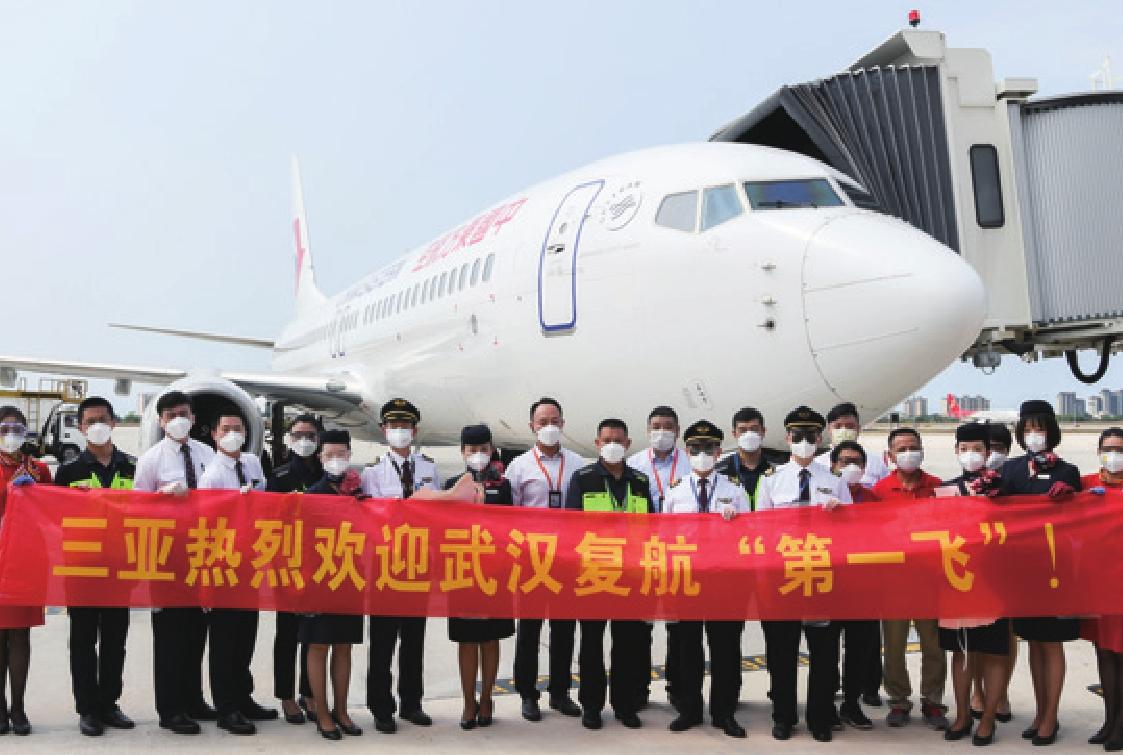BUSTLING WITH ACTIVITY
By Yuan Yuan


With horns blasting on ferryboats, the city of Wuhan in Hubei Province in central China, the epicenter of the novel coronavirus disease (COVID-19) in the country, declared its reopening on April 8.
Echoing the blasts, some vehicles honked their horns at the exits of the citys expressways, after waiting for hours for the barricades to be lifted for the city that had endured a 76-day lockdown.
After getting the news about the reopening, Zhang Lu, a Wuhan resident, drove to the Wudong highway toll station on April 7 to confirm the news. She then drove back to downtown, deciding to come back early on April 8.
Cai Xiaoxia couldnt wait either. She drove to the toll booth of the Wuhan west highway station at 10 p.m. on April 7, two hours before the removal of the barricade. She became the first to get onto the highway after its reopening.
“I have been waiting for this moment for over two months,” Cai told reporters surrounding her. She came to Wuhan to visit relatives before the Spring Festival and was trapped by the sudden lockdown. “My family members in Jingzhou (another city in Hubei) miss me a lot, too. I want to see them as soon as possible.”
The city was shut down at 10 p.m. on January 23, one day before the Chinese New Years Eve, the most important festival in China.
Two-way flow
While many are rushing out of the city, others are returning to it.
Wang Xiurong, a 40-year-old, came back from Henan Province with her husband. They waited at the toll booth in the late night of April 7 for a friend to pick them up. The couple runs a breakfast outlet in Wuhan. “Weve been looking forward to coming back to Wuhan since late January,” Wang said. “We worry about our business a lot and hope everything goes back to normal soon.”
The railway stations in Wuhan are no less busy. At 00:50 a.m. on April 8 at the Wuchang Railway Station, 442 passengers boarded a train to Guangzhou, capital of Guangdong Province, making them the first batch to leave Wuhan by train after the city reopened.
“The station had been quiet for over two months,” Xu Fang, a worker at the Wuchang Railway Station, told ThePaper.cn, a news portal.“Everybody is excited to see it is getting back on track. It is the feeling of victory over hardship.”
All the passengers leaving Wuhan need to show their health codes on their phones and have their temperatures checked at the station before boarding.
On April 8, about 55,000 passengers left Wuhan on trains. To reduce the possibility of infection, they sat apart, with at least one empty seat in between.
The Wuhan Tianhe Airport, however, was not very busy at midnight as the earliest flight was scheduled to leave after daybreak.
“In the past 76 days, the airport was abnormally quiet,” said Yuan Yizhe, a dispatcher at the airport, on April 8, “Except for some flights delivering aid goods and supporting medical teams, no other flights could get access to this airport.”
The first flight leaving Wuhan on that day was destined for Sanya, Hainan Province in south China. There were only 46 passengers on this flight and most were traveling to get back to work.
“The number of flights on April 8 was just about one fifth of that on a regular day,” Yuan said, “Moreover, since the epidemic is not over, there is a limit on the number of passengers on each flight.”

Everyone getting out of Wuhan is required to go through a two-week mandatory quaran-tine, either at home or at a designated venue after they arrive at the destination.
Flavor of life
In downtown Wuhan, after being stranded at home for two months, residents can now go out.
“Grabbing a quick morning bite,” or guo zao, is the expression Wuhan residents use for“having breakfast.” Since Wuhan is an important transportation hub in China with the Yangtze River passing through, people used to get up early to have breakfast at food stands.
Hot dry noodles, a type of boiled noodles with sesame sauce and pickles, is the iconic morning food in Wuhan.
“Normally we open two days after the Spring Festival. Now we are about two months late,” Lu Yanju, who is in charge of a branch of Cailinji, a time-honored restaurant chain in Wuhan, told ThePaper.cn.
In February, to meet the strong demand for hot dry noodles, Cailinji launched group buying and delivered to local communities. After the easing of the epidemic situation, the first branch of Cailinji resumed business on March 23. Lus branch reopened on March 26.
The number of orders surprised Lu. On the first day, Lu prepared noodles for 100 orders, and they were sold out by 9 a.m. Now, they can fill 400 orders each day. Even though the eatery can only provide takeaway service, customers still choose to patronize it, with some eager ones eating on the street right after buying the noodles. “People not only miss the taste of the noodles but also the aroma of breakfast wafting on the street,” Lu said. “The sight of eaters on the street makes me feel the city is finally coming back to life.”
Long Tao, a 54-year-old teacher in a kin- dergarten in Wuhan, is busy exercising at home to lose the weight she gained during this long break. “I gained 5 kg,” Long said. “I must be in good shape to get back to work.”
Long used to take part in square dancing to stay fit and it is the exercise she missed most while trapped at home. Now the dancing groups are returning too. “The only difference is that we must put on masks,” Long said.
In the downtown, most of the shopping malls are already open. Even though the date for reopening schools has not been decided and people must show the health codes and have their temperature checked while entering residential compounds, parks and many public areas, the city has largely come to life.
Back to work
On April 7, the No.7 Jianghan Bridge in Wuhan resumed construction after a two-month suspension, making it the first bridge project to be restarted in the city.

The construction workers had undergone mandatory quarantine for 14 days before getting back to work on site. They are required to report their health condition via WeChat every day. The company has prepared virus-prevention materials including masks and disinfectants for disease prevention.
“The construction was halted, but we are confident we will make up for the delays,”Mei Jiansong, who is in charge of the project on site, told Xinhua News Agency.
With the novel coronavirus epidemic effectively contained in Wuhan, the local epidemic prevention and control authority in the city has asked enterprises undertaking major projects to resume operation.
At a news briefing on April 5, Hu Yabo, Executive Vice Mayor of Wuhan, said major automobile and electronic product manufacturers have all resumed production, including Chinas tech giant Huawei and Foxconn, a key supplier for Apple.
Hu also said that the government will draft tailor-made plans to help companies deal with difficulties in funding, logistics and transportation of workers. By April 4, about 76 percent of projects with investment of over 100 million yuan ($14.3 million) had been put back on track. “So far, not a single case of infection has been reported from workplaces,” Hu said.
With more businesses and major projects being resumed, Hu said, the city will give great importance to epidemic control at workplaces to ensure the virus does not spread again.
Official statistics show that on April 7, there were 181 severe cases in Wuhan. On April 8, this number decreased to 135.
“Most of the remaining severe cases have tested negative for the novel coronavirus,” Jiang Li, a doctor from Beijing Xuanwu Hospital who is now in the Jinyintan Hospital in Wuhan, told Caixin magazine. “Now we are focusing more on treating the complications and other chronic diseases of these patients.”
“China is facing rising pressure of imported COVID-19 cases,” Zhang Wenhong, Director of the Infectious Diseases Department of the Shanghai Huashan Hospital, told China Central Television.“Vigilance is still highly needed to prevent the disease from going viral again.”

